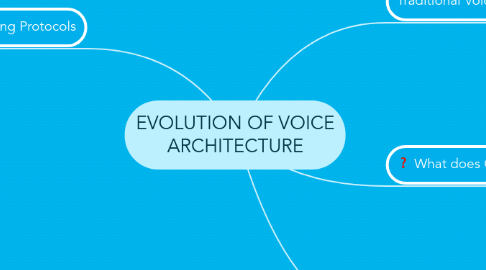
1. VOIP Signaling Protocols
1.1. H323
1.1.1. Is a standard that specifies the components, protocols, and procedures that provide multimedia communication services.
1.1.1.1. Define all aspects of synchronized voice, video, anda data transmissions. It also defines end-to-end call signaling
1.1.2. Umbrella of protocols designed for audio-video communications.
1.1.3. Widely used in Gateways, Gatekeeper or third party H323 clients, specially video terminals in Cisco Unified Communications.
1.2. MGCP
1.2.1. Media Gateway Protocol is a method for PSTN or VOIP gateway control or thin device control.
1.2.1.1. With MGCP,a gateway is the entry point to the voice network.
1.2.1.1.1. MGCP defines a protocol that controls the VoIp Gateways that are connected to external call-control devices referred to as call agents.
1.2.2. Is an example of master-slave protocol, where the endpoint
1.3. SIP
1.3.1. Developed by the IETF, is very distributed. Each endpoint (user agent [UA]) uses technologies from the Internet (DNS, MIME, HTTP, and so on) to establish and maintain sessions.
1.3.2. SCCP
1.3.2.1. Skinny Client Control Protocol (SCCP) is a Cisco proprietary protocol that is used for communications between Cisco Unified Communications Manager (CUCM), the Cisco implementation of the communication manager function described earlier, and terminal endpoints. It is therefore different from the three other protocols listed here in its scope, because it is limited to endpoint to CUCM connections. The CUCM then uses another protocol to communicate with external systems.
2. COMPARISON
2.1. MGCP
2.1.1. Very Centralized
2.1.2. Ideal for large ans scalable deployments with few central points of control.
2.2. H323
2.2.1. More distributed than MGCP
2.2.2. Support voice & multimedia Communication
2.3. SIP
2.3.1. Built to be very distributed
2.3.2. Based on internet Protocols
3. Traditional Voice Network
3.1. CO = Central Office Switch
3.2. PBX= Acts as Bridge between the external world and the internal phone network.
3.3. Gatekeeper= Provides CAC, bandwidth control and management.
3.4. Gateway= Provides translation between Voip and non-Voip Network such as the traditional Telephone network (PSTN)
4. What does Call Control
4.1. Determinate is the call can be placed in good conditions based on information such as bandwidth availability, user rights, and so on.
4.2. Routing the Call
4.3. Monitoring the quality of the call.
5. Communication Manager Locations
5.1. Centralized Model
5.1.1. All the future are grouped in a central location. The IP Phones or the branch systems are just used to connect to the central system
5.1.1.1. Benefits
5.1.1.1.1. Easy to configure, if the link to the central location fails, Survivable Remote Site Telephony allow the branch to continue to function with little impact on the end users.
5.2. Distributed Model
5.2.1. Each Branch has its own communication Manager Unit. This model is typical deployed where there are high concentration of IP Phones.
